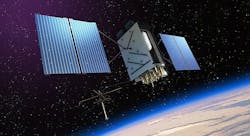Northrop Grumman to shrink size of GPS satellite electronics with signal-generation upgrade
Microelectronics experts at the Northrop Grumman Corp. Aerospace Systems segment in Redondo Beach, Calif., will design new L-band radio frequency power amplifiers for the GPS satellite navigation payload under terms of a $7 million contract announced Tuesday from the Air Force Research Laboratory Space Vehicles Directorate at Kirtland Air Force Base, N.M.
Northrop Grumman experts are working to demonstrate the direct digital synthesis of GPS signals by designing a digital beam forming element, engineering design unit, and other enabling technologies of the digital phased array GPS payload.
Direct digital synthesis is a way of producing an analog signal in digital form and then performing a digital-to-analog conversion. Because operations primarily are digital, this process can offer fast switching between output frequencies, fine frequency resolution, and operation over a broad spectrum of frequencies.
With advances in design and process technology, today’s direct digital synthesis devices are compact and draw little power. This process can provide agile sources of low-phase, noise-variable frequencies with good spurious performance for GPS navigation signals, communications, and other RF and microwave applications.
Direct digital synthesis is gaining a reputation for generating analog signals efficiently because today's single-chip integrated circuits can generate programmable analog output waveforms simply and with high resolution and accuracy.
Related: U.S. Air Force Research Laboratory seeks smaller GPS satellites
Continuing improvements in integrated circuit process technologies have helped reduce the costs and power consumption of integrated circuits for direct digital synthesis.
On this contract Northrop Grumman will do the work in Redondo Beach, Calif., and should be finished by March 2015. For more information contact Northrop Grumman Aerospace Systems online at www.northropgrumman.com, or the Air Force Research Laboratory Space Vehicles Directorate at www.kirtland.af.mil/afrl_vs.
